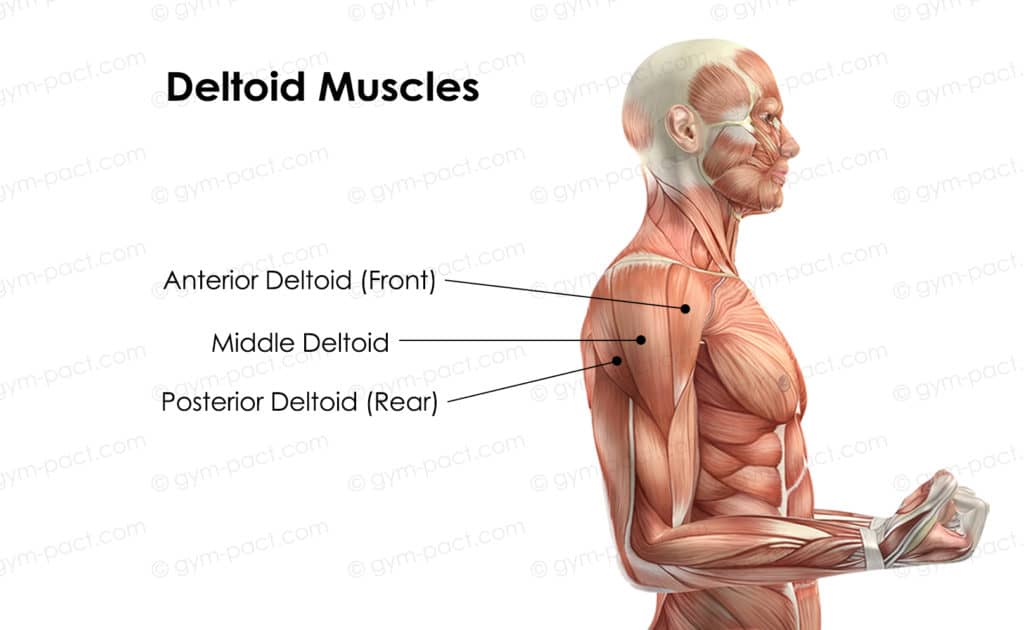One of the best ways to dramatically increase your aesthetics is to build your deltoids. Your deltoids are the anatomical term for your shoulder muscles.
The deltoid muscle is actually comprised of 3 different muscles; the anterior deltoid (front), the middle deltoid, and the posterior deltoid (rear). The reason there are three different muscles is due to the large range of motion and action which the shoulder is capable of.

This article will look at the best rear delt exercises. The rear deltoids are primarily responsible for extending the shoulder with the assistance of the lats. Extension of the shoulder occurs when the elbow is brought down and back as seen in many pulling exercises such as rows.
Increasing the strength and size of the rear deltoid can greatly increase the strength in pulling movements, add to shoulder stability, and improve posture.
This article will provide you with the best rear deltoid exercises to do just that.
1) Bentover Barbell Row
Rowing movements, in general, are going to consist of the bulk of your compound movements to hit your rear deltoid muscles. Remember, the main function of the rear deltoid is pulling the arm down and back. The bent over barbell row is perhaps the best version of rows due to the amount of load you can use and the amount of muscle mass. You hill hit your entire upper back; lats, traps, rhomboids, and of course, the rear delts. In addition, you will get an isometric contraction in your lower back, glutes, and hamstrings. Oh yea, your biceps get a great workout as well
Equipment
- Barbell
- Weights
Instructions
- Grab the barbell slightly wider than shoulder-width apart
- Pick up the barbell in the same manner as the deadlift. This is the best starting position
- Feet should be hip-width apart Slightly bend the knees to allow your torso to come forward and down
- Only push your butt back slightly. You should put emphasis on bringing the torso forward more so than pushing the hips back
- Keeping a slightly arched back, and let the arms hang freely.
- They should hang in front of the knees
- Pull the bar up by pulling your elbows back. Keep them close to your side
- Pull the barbell into the belly button.
- Slowly lower the weight
2) Dumbbell Incline Row
The dumbbell incline row is another great rowing exercise that will work your shoulders. Using an incline bench limits the amount of body movement you can use which means a tad more isolation on the pulling muscles including the back and rear delts
Equipment
- Adjustable bench
- Pair of Dumbbells
Instructions
- Set the bench at a 45-degree incline
- Lay down on the bench pronated with your chest on the bench. Keep your feet planted
- Grab the dumbbells with an overhand grip
- Pull the shoulder blade back
- Pull the dumbbells up by focusing on pulling your elbows back
- Pull the dumbbells all the way up until they reach the level of your side
3) Rope Face Pull
Rope face pulls are a favorite exercise for shoulder health and development. This is true for just about every type of lifter; bodybuilders, powerlifters, athletic performance, rehab…they all get receive benefit from this exercise. The face pull can be used in either a back workout or shoulder workout. Or both! Due to its pulling motion with the elbows up, you will take the stress off the lats and put more emphasis on the traps, rhomboids, and rear delts. A band face pull is also a great variation to do at home.
Equipment
- Cable machine
- Rope attachment
Instructions
- Set the cable so that it is about eye level
- Grab the ropes with an overhand grip and thumb towards you
- Pull the rope into your face. As it gets close, pull the rope apart to go around your head
- IMPORTANT: Keep your elbows high the entire time. They should be at shoulder level
4) Dumbbell Reverse Fly
The dumbbell reverse fly is a tough movement. It is performed by laying on an incline bench, but lower than 45 degrees. You then take dumbbells and pull them out to the side like you’re getting ready to give someone a big hug. Due to the distance from your body, a small dumbbell will feel very heavy so go light. Further, the weight will grow increasingly heavier throughout the movement as the dumbbell moves away from you.
Equipment
- Adjustable bench
- Pair of dumbbells
Instructions
- Adjust the bench so that it around 30 degrees
- Lay down on the bench with your chest on the pad
- Grab the dumbbells with a neutral grip
- Push your chest into the pad and retract your shoulder blades
- Pull the dumbbells out and away from your body until they become roughly parallel
- Maintain a slight bend in your arm
5) Cable Crossover Reverse Fly
Using the cable crossover will allow the same movement as the dumbbell reverse fly, except it will allow for both a greater range of motion as well as more consistent tension. This exercise can easily be done using both arms at once, or by isolating one side at a time.
Equipment
- Cable Machine
- Single Handle
Instructions
- Adjust the cables so that they are slightly above your head
- Stand in the middle of the cable crossover machine, slightly outside
- Grab the handles by using opposite hands. The right-hand grabs the left handle; the left-hand grabs the right handle
- Retract shoulder blades
- Pull the cables out and back until your arms are relatively parallel
- Keep a slight bend in your elbows
6) Standing Shoulder Press
The standing shoulder press is a must for anyone looking for maximum shoulder development and stability in the shoulder complex. While the anterior delt won’t be specifically hit in overhead movements, it will increase its ability as a stabilizer which lends itself to a healthy shoulder. This is what we want.
Equipment
- Rack
- Barbell
- Weights
Instruction
- Rack the bar slightly below the shoulders
- Grab the bar with an overhand grip, slightly out side the shoulders
- Unrack the bar. KEEP the elbows underneath the bar
- Tighten your core and squeeze your butt. This is to brace while pushing
- Push the bar overhead until your elbows lockout
- Make sure to keep the back straight
7) Arnold Press
The Arnold Press is a classic exercise made famous by Arnold Schwarzenegger. Many people think they are doing the Arnold Press, but they are actually doing the Callahan Press below. The Arnold Press is merely doing a shoulder press with external rotation. At the bottom, your palms are facing towards you. As you push up, your hands will rotate so that they will face away from you at the top when your arms are fully extended.
Equipment
- Seated chair preferably with high backrest
- Pair of dumbbells
Instructions
- Sit down on a chair with feet planted on the ground and the back pushed into the back
- Bring the dumbbells in front of you. Your palms should be facing you and the dumbbells in front of your face
- While pressing up, rotate your elbows out. This should start to turn your wrist outward
- Push to the top. Your palms should now be facing away from you
8) The Callahan Press
As mentioned, many people who think they are doing the Arnold Press are actually doing the Callahan Press. Unlike regular pressing movements which only move vertically, the Callahan Press also incorporates horizontal abduction/adduction. Horizontal abduction (the arms moving backward) relies on the anterior delts to pull the arm back. This gives the rear delts a little bit more attention than other pressing movements.
Equipment
- Optional: Chair
- Pair of dumbbells
Instructions
- You can do these standing or sitting
- Grab the dumbbells and bring them up so that your elbows make a relative straight line. Palms facing away
- Have your elbows bent 90 degrees so that the dumbbells are directly above the elbow
- Push up and do a press and come back down
- Now, pull your arms together so that they meet in front of you. Your elbows still bent at 90 degrees
- Bring them back out to your side
9) Pronated Cable Rear Delt
This movement will utilize the cable crossover machine again to hit the rear deltoids However, instead of standing up, you will be bent over in a pronated position. Further, you will not use an attachment. Grabbing just the cable allows your grip to stay pronated.
Equipment
- Cable Crossover
- Optional: SIngle handle
Instructions
- Set the cable at its lowest level
- Stand so that you are looking into the crossover
- Get in a bent over position so that your back is at a roughly 90-degree angle. Keep your back straight
- Grab the cable with the hand farthest from the cable. You can use an attachment or just grab the ball
- Pull the cable out and away from your body
10) Fly Machine
The Fly Machine isn’t made just for the chest. By turning around, you can isolate your read delts. This is a great movement to use towards the end of your training session as the machine really isolates the muscle.
Equipment
- Fly Machine
Instructions
- Set the bars in the position farthest back
- Sit down on the pad. Adjust the pad so that you can reach your arms straight out and grab the handle
- Retract your shoulder blades
- Pull the handles out and back until they are almost parallel. Keep the arms slightly bent
Now Don’t Forget Them!
The posterior deltoids are hardly thought of when people train. You don’t really see them much compared to the other two heads so training them is less obvious. However, don’t make the mistake and ignore them. By using the above exercises to train your rear delts, you will not only add size to your overall shoulder development, but will also dramatically increase your pulling power and stabilizing power
Frequently Asked Questions
What is the fastest way to build rear delts?
The best way to increase the size of your delts is to primarily work in the hypertrophy range of 8-12 reps. However, you should also include some more strength movements as increasing strength will allow you to do more volume.
Therefore, you should have 1-2 compound exercises that hit your rear delts using heavy loads in the 4-6 rep range. Then use 2-4 assistance or isolation movements in the 8-12 rep range.
You should aim to train your rear delts twice a week
Should I train rear delts with back or shoulders?
The rear delts can be trained with multiple upper body training programs. It really is going to depend on how your specific program is set up. Keep in mind that you will always hit the rear delts during both shoulder and back days; however, it will generally be trained more during back days.







